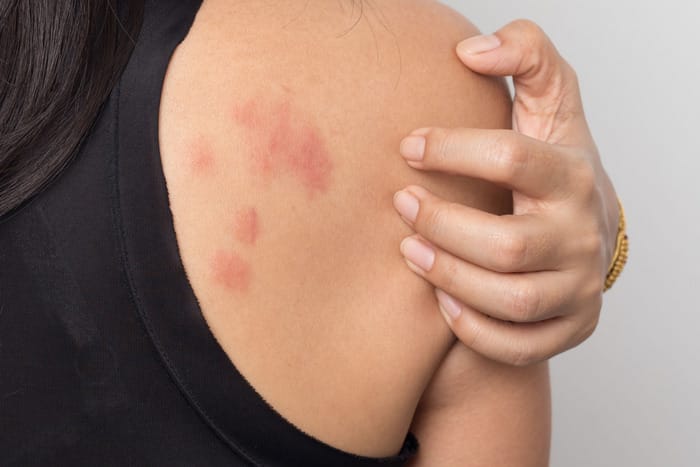The Seasonal Skin Allergy Epidemic
Seasonal skin allergies affect over 50 million Americans annually, with spring and fall being peak seasons. Unlike year-round allergies, these flare-ups coincide with:
- Pollen surges (tree pollen in spring, ragweed in fall)
- Temperature fluctuations
- Humidity changes
- Increased outdoor activities
Key Facts:
- 40% of allergy sufferers experience skin symptoms
- Children develop seasonal allergies 3x more often than adults
- 60% of cases show genetic predisposition (JACI, 2023)
Section 1: Skin Biology & Allergy Mechanisms
The Skin’s Defense System
Your skin comprises three critical layers:
| Layer | Thickness | Key Functions | Allergy Relevance |
|---|---|---|---|
| Epidermis | 0.1-1.5mm | Barrier protection, melanin production | irst contact point for allergens like pollen grains ((American Academy of Dermatology)) |
| Dermis | 2-4mm | Contains sweat glands, hair follicles | Histamine release causes itching |
| Hypodermis | 1-2cm | Fat storage, temperature regulation | Rarely affected by surface allergies |
Clinical Insight: A compromised skin barrier allows pollen grains (20-60µm) to penetrate deeper layers, triggering immune responses.
How Seasonal Allergies Develop
The allergic cascade involves:
- Sensitization: Initial allergen exposure creates IgE antibodies
- Mast Cell Activation: Subsequent exposure triggers histamine release
- Inflammation: Cytokines cause redness/swelling
- Chronic Changes: Repeated exposure may lead to:
- Lichenification (thickened skin)
- Post-inflammatory hyperpigmentation
Section 2: Symptoms & Differential Diagnosis
Common Presentations
Mild Cases:
- Localized erythema (red patches)
- Pruritus (itching) without rash
- Dry, flaky patches
Moderate-Severe:
- Urticaria (hives) with welts
- Angioedema (facial swelling)
- Eczema flares
- Allergic conjunctivitis (“eye allergies“)
Rare But Serious:
- Stevens-Johnson Syndrome (requires ER care)
- Allergic contact dermatitis
Symptom Comparison Table
| Condition | Duration | Key Features | Triggers |
|---|---|---|---|
| Seasonal Allergies | Weeks-months | Itchy eyes/nose, clear discharge | Pollen, mold |
| Eczema | Chronic | Dry, cracked skin | Stress, irritants |
| Contact Dermatitis | 2-4 weeks | Geometric rash patterns | Nickel, fragrances |
Section 3: Top 5 Seasonal Triggers (2024 Research)
- Tree Pollen (Feb-May)
- Birch, oak, cedar most allergenic
- Cross-reacts with certain foods (Oral Allergy Syndrome)
- Grass Pollen (May-July)
- Bermuda, Timothy, Ryegrass
- Adheres to skin during outdoor activities
- Ragweed (Aug-Oct)
- Single plant releases 1 billion pollen grains
- Travels up to 400 miles
- Mold Spores (Peak in humid months)
- Cladosporium, Alternaria species
- Thrives in decaying leaves
- Temperature Extremes
- Cold air: Dries skin barrier
- Heat/sweat: Irritates sensitive skin
Section 4: Medical Treatments (Updated Protocols)
First-Line Therapies
| Medication Type | Examples | Mechanism | Best For |
|---|---|---|---|
| Oral Antihistamines | Cetirizine, Fexofenadine | Blocks H1 receptors | Itching, hives |
| Topical Steroids | Hydrocortisone 1%, Triamcinolone 0.1% | Reduces inflammation | Eczema flares |
| Immunomodulators | Tacrolimus ointment | Calms T-cell response | Face/neck rashes |
Advanced Options
- Biologics: Dupilumab for severe eczema
- Phototherapy: UVB treatment for chronic cases
- Allergy Shots (AIT): 3-5 year commitment, 80% efficacy
Section 5: Prevention & Skin Care Routine
Daily Protection Plan
Morning:
- Cleanse: Hypoallergenic ceramide wash
- Barrier Repair: Niacinamide serum
- Moisturize: Fragrance-free cream with colloidal oatmeal
Evening:
- Pollen Removal: Micellar water rinse
- Cool Compress: Calms inflammation
- Occlusive: Petroleum jelly on extra-dry areas
Environmental Controls
- Indoor:
- HEPA air purifiers (change filters monthly)
- Humidity maintained at 40-50%
- Remove outdoor clothing at entryway
- Outdoor:
- Check pollen counts (use Weather.com Allergy Tracker)
- Wear wide-brimmed hats + long sleeves
- Post-activity: Shower within 30 minutes
Section 6: Natural Remedies (Evidence-Based)
Proven Alternatives
- Colloidal Oatmeal Baths
- Reduces itching by 32% (Dermatitis, 2022)
- Use lukewarm water (hot water worsens dryness)
- Probiotic Skincare
- Lactobacillus strains improve skin barrier
- Look for fermented ingredient products
- Dietary Support
- Quercetin-rich foods (apples, capers)
- Omega-3 supplementation (reduces inflammation)
Caution: Essential oils may worsen allergies – patch test first!
When to See an Allergist
Seek professional help if:
- Symptoms persist >2 weeks
- Over-the-counter meds fail
- You experience:
- Facial swelling
- Difficulty breathing
- Blistering rash
Diagnostic Tools Allergists Use:
- Patch testing
- Specific IgE blood tests
- Skin prick testing
Key Takeaways
- Seasonal allergies involve complex skin-immune interactions
- Pollen avoidance is equally important as topical treatments
- Consistent skin barrier repair prevents severe reactions
- Advanced therapies exist for resistant cases
Immediate Action Steps:
- Download pollen forecast apps
- Invest in HEPA filters
- Start a skin diary to identify triggers
“Managing seasonal skin allergies requires both defensive strategies and targeted treatments.” – Dr. Sarah Chen, American Academy of Allergy, Asthma & Immunology

